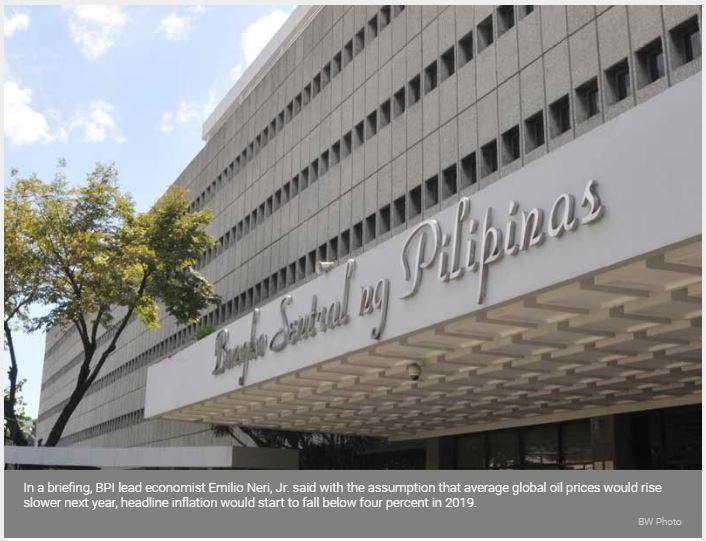Philippines: With rate freeze, BSP seen to trim bank reserves
MANILA, Philippines — The Bangko Sentral ng Pilipinas (BSP) may no longer raise policy rates in December as inflation is expected to ease toward the end of 2019, giving it space to bring down the reserve requirement for banks, the chief economist of the Bank of the Philippine Islands (BPI) said yesterday.
In a briefing, BPI lead economist Emilio Neri, Jr. said with the assumption that average global oil prices would rise slower next year, headline inflation would start to fall below four percent in 2019.
This is based on the assumption that oil prices, as represented by West Texas Intermediate (WTI), may rise less than five percent in 2019 compared with the unusual surge of more than 40 percent this year.
“We believe that the BSP may no longer need to hike policy rates in its December policy meeting as lower monthly Philippine inflation prints are expected beginning November through end-2019 compared to the 6.7 prints seen last October and September,” Neri said.
He noted, however, that while the return of inflation to the four percent level would give the BSP some policy space, reducing policy rates would be premature unless the growth in consumer prices breaches the two percent level.
“We don’t think the BSP would cut rates unless inflation rate breaks below two percent,” he said.
However, he said the BSP should be encouraged to reduce the reserve requirement ratio (RRR) on deposits of commercial and universal banks which is currently at 18 percent, the highest among the ASEAN-5 countries that include Indonesia, Malaysia, Singapore and Thailand.
Doing so would increase money supply in the economy, therefore boosting economic activity, while keeping inflation in check.
“While we don’t think they will be cutting the policy rate, we believe there is enough policy space for the BSP to continue reducing the reserve requirement ratio,” said Neri.
A cut of at least two percentage points can be expected in the middle part of 2019, he said.
He expects inflation to average at a range of 5.2 percent to 5.3 percent for this year and 3.6 percent next year.
As far as bank lending is concerned, the cumulative 175 basis points policy rate hike from November to May this year would indeed slow down the growth in borrowing activity from commercial banks but is unlikely to cause a decline in lending activity, Neri said.
With the last 25 basis points rate hike, the policy rate was raised from 4.50 percent to 4.75 percent.
“It would take a lot for bank lending growth to not move at all in 2018 to 2019. The policy rate has to move up to as high as 10 percent,” said Neri.
Cutting the RRR, he said, could provide a boost to the economy that has been seeing slower growth as elevated inflation erodes consumer spending and business expansion.
“If inflation comes back to the BSP target level, the environment would be more favorable to business expansion and stronger consumption,” said Neri. ”If we see a good correction in interest rates next year because of lower inflation, GDP should be 6.5 percent to seven percent more if BSP can cut the reserve requirement by more than two percentage points.”
Neri said this would also enable banks to remain competitive amid the rise of financial technology solutions.
“Once we are on target, we believe the BSP will take the initiative to reduce the very repressive reserve requirement. We have very high capital adequacy among the banks and keeping reserve requirements at 18 percent is keeping the system too tight. Fintech is also happening very fast and we have to level the playing field. So high reserve levels is unfair to the traditional banking sector,” said Neri.
Source: https://www.philstar.com/business/2018/11/23/1870845/rate-freeze-bsp-seen-trim-bank-reserves#207Us83bz3lyFg0q.99


 Thailand
Thailand




